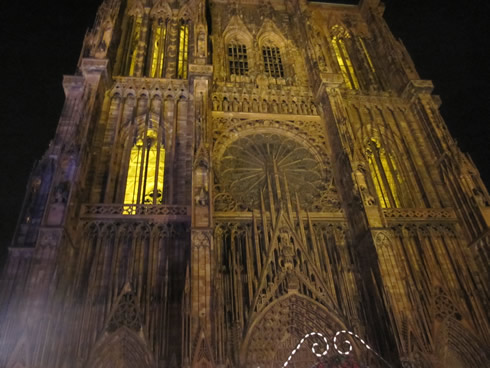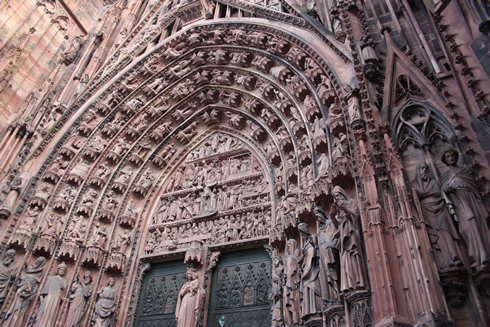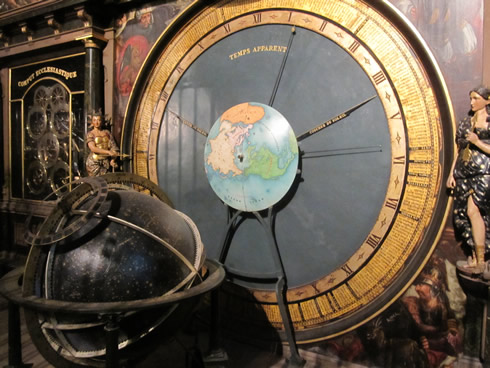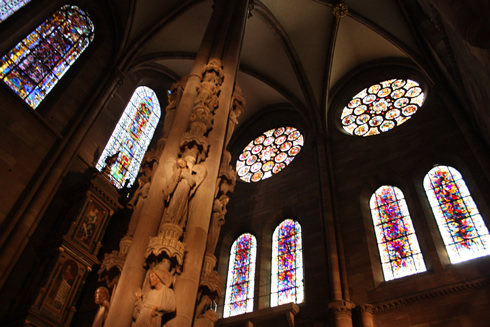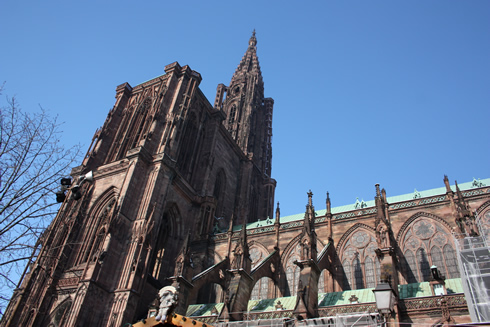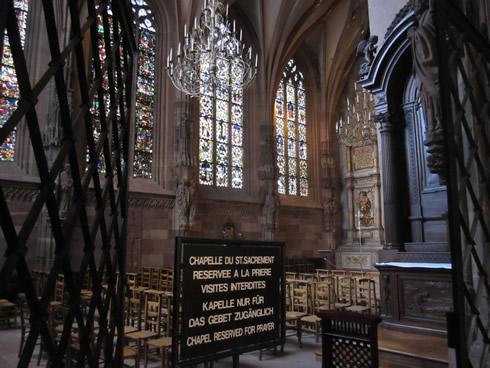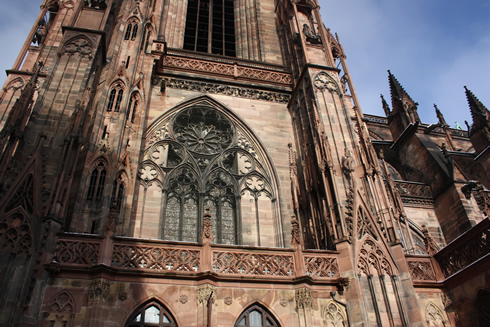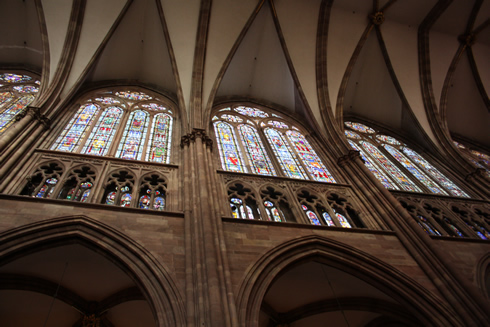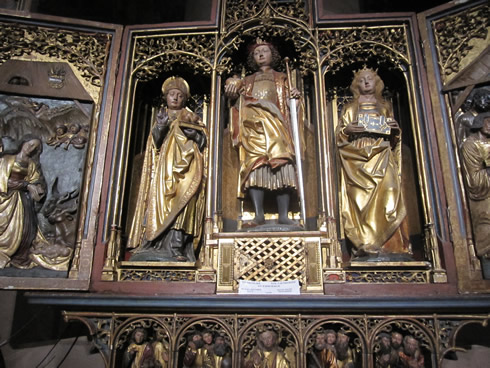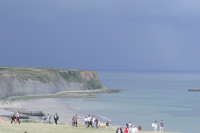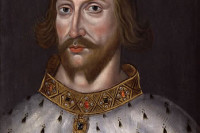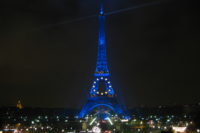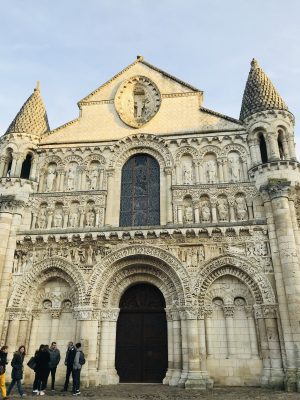Travel
Understanding the world of cathedrals: Cathedral of our Lady in Strasbourg (France) Part 1
Since my last visit in 1998 to the cathedral of Strasbourg, I had been longing to go back. Finally over the Christmas holidays, I took the train from Zurich with one major goal: learning more about the cathedral.
In twelve years, the images of the magnificent Great rose window, the illuminated choir and the grandiose facade had remained strongly in my memories.
I had to go see Strasbourg, a city on the UNESCO list since 1988, and of course visit its cathedral.
You might think visiting during the holiday season may not be the best time as the cathedral is hidden behind the Christmas markets and surrounded with thousands of tourists. But seeing it all lit up with Christmas stands around, trees and being able to drink and eat specialties of the season at the same time is also quite nice. Plus, during that time one can enjoy the nativity scenes (crèche) and tapestries inside.
Like other artists before me, Strasbourg’s cathedral had left some
strong impressions on me. That was during a time I was less interested
in sacred sites than now.
Victor Hugo, Stendhal, Paul Claudel and Goethe all were interested in the Strasbourg cathedral known as Cathedral of our Lady.
The French poet, Paul Claudel, loved the cathedral so much that he used the term “pink red angel” to describe it. German writer, Goethe, marveled about the facade and called its spire a “true triumph”.
Yes, indeed the Western facade is truly amazing especially the central portal. Carved bas-reliefs, statues of saints and angels, story of the Day of Judgment, life of Christ and many more symbols can be observed from the outside.
For me, the best way to learn about this exceptional site is to take a guided tour. Our guide, Marcel, met us under the big attraction of the cathedral: the astronomical clock.
It is with a friendly smile that she talked to us over an hour, recounting us every story she could think of. No doubt, that she not only know the topic well, but she loved the cathedral.
About the astronomical clock:
The 59 feet (18 meters) high clock is quite an attraction, bringing according to the cathedral website, 3 million visitors a year, just to see it.
I have never seen anything like this in any other cathedral!
Animated characters come out from 6:00 a.m. to 6:00 p.m. “Death rings the time”, mentions our guide, “but in real life death comes anytime!”
It is a sun clock so there is a 1/2 time difference with the actual time. Every day at 12:30 p.m. (written noon on the clock) a rooster comes out and sings. We can see angels, a baby, a young man and an older man.
The clock shows the time, days of the week but can also predict astronomical changes.
For leap years another window opens up automatically. One time, it broke down on a day of Pentecost and everyone was upset and could not believe it.
But what happened to the other clocks?
The first one built during the middle of the 14th century worked until the beginning of the 16th. It was called “clock of the three kings” and was placed on the opposite side of the new clock. If you are interested it can be seen at the nearby museum of Rohan in Strasbourg.
It took a while for the second clock to be built. From 1547 to 1571, the Swiss Habrecht brothers (Isaac and Josias) from Schaffhausen in Switzerland worked on the design from Conrad Dasypodius, a mathematician of Strasbourg. In 1788/89 it stopped working.
A legend says that someone poked the eye of the architect so he would not redo the same thing somewhere else.
Pillar of Angels:
In the Southern transept, just next to the astronomical clock stands the pillar of angels. On the pillar in the center stands twelve statues. It is called Pillar of the Last Judgment.
It was put there to safely be able to carry the ribbed vaults. The sculptures are fantastic. Marcel points out all of the fine creases in the clothing. You can notice all of the human body morphology and how flexible the body can be. It looks like the noble Greek sculptures.
This pillar was probably completed in the 1230’s.
The crypt:
The tour started in the crypt just under the choir. If you don’t take the private tour, you will not be able to see the crypt. It is normally closed to the public, only opened for some masses.
The crypt is an important place. That is where one finds some remains of the church built during the time of Bishop Werner of Habsburg in the 11th century. The oak pillars, still here, carry the actual cathedral.
One feels a Byzantine influence with very decorated pillars with fantasy animals.
In one part of the crypt everything is very compact, horizontal. During this period one was worried it would fall down.
Then, further toward the West, the pillars are more slender and the vaults are crossed. The pillars are almost gone.
About the cathedral:
While sitting down, our guide tells us something quite interesting about the building of the cathedral. Not only the spire is 465 feet (142 meters) high, but the cathedral is located at an altitude of 465 feet (142 meters). “Is that a coincidence?” wonders Marcel. Strange when at that time one did not know how to calculate altitude.
To reach to the cathedral, one needs to go up. It is the highest point in town. The place was chosen as it was the driest area to build sacred sites such as temples, churches and cathedrals.
History of Gothic style:
The cathedral is of Gothic style. As it was built over many centuries it shows different styles of Gothic until the style was too tired and had given enough. The goal in Strasbourg like in other Gothic cathedrals is to go toward God. Then during the Baroque era it is God
that goes toward the people.
Before during the Roman times, the Roman style was unique to its region, explains Marcel. So we had for instance Burgundian, Rhenish styles… It is not the case with Gothic, one has one international term. The style differs a bit depending if it is during the early,
middle or late Gothic.
So what will we see here like in other cathedrals of the Gothic time?
High windows, roses, a triforium, ribbed vaults which demultiply the weight with flying buttresses.
About the eventful history:
For some, the history of the cathedral goes with the history of the city.
It is under political intrigues, wars and plagues that the cathedral was built. Money was often lacking. Built over 4 centuries, the work was led by many architects and bishops.
It underwent fires, earthquakes, bombings, a revolution and even got into the hands of the Protestants.
The city of Strasbourg starting in the 5th century became a bishopric.
What was there before the actual Cathedral of our Lady? A Roman temple. King Clovis built a Carolingian church in 510.
Later in the 11th century, the archbishops were powerful and had much authority.
During that time, the Romanesque basilica was destroyed by a fire and it was reconstructed. The place became a cathedral, made of wood. Bishop Werner von Habsburg led the reconstruction. It was consecrated in 1025.
After the 1176 fire it was decided that this time it would be built of stone and not of wood. The bishop was Henry of Hasenburg. Work ended in 1439 with John Hürtz.
For the actual cathedral the chancel and the oak pillars are used in the foundation. The goal at the time was to build a better and bigger cathedral than the neighboring cathedral of Basel.
In 1190 one tried to build in Strasbourg an ambulatory, but the plan did not succeed. In Basel one had the same hopes and the Swiss succeeded.
In 1284 Erwin von Steinbach (Baden) took over the work at the demand of Conrad of Lichtenberg. One knows despite proof of document that Erwin von Steinbach was the architect of Strasbourg. He was a famous master, as known as Johannes Gutenberg.
Plans changed many times under Erwin. It could have been two towers, but Strasbourg will only have one.
The cathedral of Strasbourg only got one spire. You may wonder why? Only one was planed. Architect Ulrich von Ensingen from Ulm started working on it but the arrow was put only in 1439. Even if later on, more thought was given about a possible second arrow, it never happened.
In 1439, probably for technical reasons, one decided to put a stop to the building of the cathedral.
What happened to the cathedral at the end of its construction?
From 1478 to his death in 1510 the Alsatian Geiler of Kayserberg preached at the cathedral.
The Reformation was approaching and finally Strasbourg became a free city. In 1529 the Cathedral of our Lady became Protestant. No more catholic masses were celebrated. It remained under the Protestant faith until 1681 under Louis the 14th. In 1685, Strasbourg welcomed the Huguenots.
More difficult times threatened the cathedral during the French Revolution. It was almost lost, but luckily saved. The Jacobins did not allow any statues of kings. So in the niches of the galleries and on the outside facade, hundreds of statues were destroyed. Marcel says that a total of 300 were broken and removed. During the 19th century, some
copies were made.
The spire caused a problem as well. The revolutionary leader, Louis Saint Just wanted to get rid of it but it was saved by a locksmith, who got an amazing idea and disguised it with a Phrygian cap (liberty hat or bonnet rouge). The cap stayed there from 1794 to April 1802.
To be continued next week. This was Part 1 of 2.

